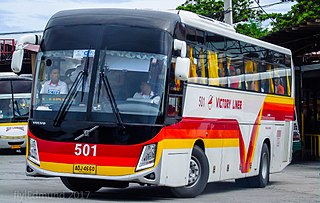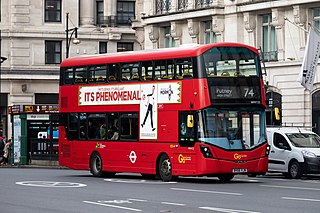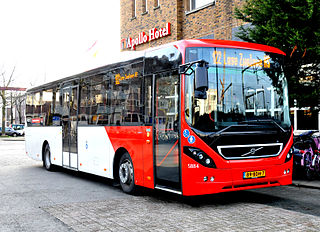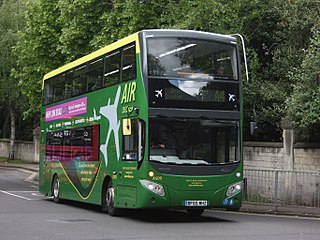
Volvo Buses, stylized as VOLVO, is a subsidiary and a business area of the Swedish vehicle maker Volvo, which became an independent division in 1968. It is based in Gothenburg.

The Volvo B9TL is a low-floor double-decker bus built by Volvo from 2002 until 2018. It superseded the Volvo Super Olympian and the Volvo B7TL. The 2-axle version has been superseded by the Volvo B5TL in 2014 and the 3-axle version has been superseded by the Volvo B8L in 2018.

The Volvo B7RLE is a low-entry single-deck bus chassis manufactured by Volvo. It was superseded by the Volvo B8RLE in 2013, with production of the B7RLE continuing until 2018.

The Volvo B7TL is a low-floor double-decker bus chassis which was launched in 1999 and replaced the 2-axle version of the Volvo Olympian. It was built as the British bus operators seemed hesitant to purchase the B7L double decker with a long rear overhang.
Volvo B7 may refer to different 6.7-, 7.1- and 7.3-litre engined bus chassis from Volvo Buses:

The Volvo B7R is a coach chassis available with a range of bodies. It is promoted as a rear engined lightweight coach chassis. It is primarily intended for tourist and long-distance duties. B7R is also manufactured in China, Brazil, Hungary, India and Iran for use in regional transport services.

The Volvo B7L is a fully low floor single-decker bus, double-decker bus and articulated bus chassis with a rear engine mounted vertically on the left of the rear overhang. It was built as a replacement for the Volvo B10L, and the Volvo Olympian, used as both a single-decker bus and a double-decker bus chassis largely in Continental Europe. The Volvo B7L was superseded by the Volvo B9L in 2006.

The Volvo B12BLE is a low-entry city and suburban bus chassis launched in 2001 with a rear-mounted transverse engine. It superseded the Volvo B10BLE and is used as a base for single-decker buses in Europe and Australia.

The Wright Eclipse Gemini is a low-floor double-decker bus body that was built by Wrightbus since 2001, based on the single-decker Wright Eclipse design. The second-generation Eclipse Gemini 2 was launched in 2009, followed by the third-generation Gemini 3 in 2013. Additionally, the body was available on Volvo Super Olympian chassis in Hong Kong between 2003 and 2005, marketed as the Wright Explorer.

The Volvo B10M is a mid-engined city bus and coach chassis manufactured by Volvo between 1978 and 2003. It succeeded the B58 and was equipped with the same 9.6-litre horizontally mounted Volvo diesel engine mounted under the floor behind the front axle. An articulated version under the model name Volvo B10MA was also offered, as was a semi-integral version known as the C10M, with the engine in the middle of the chassis.

The East Lancs Nordic is a type of low-floor double-decker bus body built by East Lancashire Coachbuilders. It was built on tri-axle double-decker Volvo B7L chassis, with a length of 12 metres and a seating capacity of up to 95 passengers. The Nordic body design is based on an elongated version of the East Lancs Vyking body, with the name "Nordic" being derived from the chassis being built by a company from Sweden. The bus was later superseded by its Myllennium counterpart in 2005.

The Wright Eclipse is a low-floor single-deck bus body that was built by Wrightbus between 1999 and 2019. The second-generation Eclipse 2 was launched in 2008, followed by the third-generation Eclipse 3 in 2015. The Eclipse, and its sister design the Solar, were named for a solar eclipse which was visible in the UK in 1999, the year of its introduction.

Drögmöller was a motor coach manufacturer based in Heilbronn, Germany. The company operated between 1920 and 2005 and was known for the production of touring coaches.
The Volvo B10 was a front-engined bus chassis built in the 1930s, but may also refer to different 9.6-litre engined bus chassis from Volvo Buses:

The Volvo 9700 is a range of coaches manufactured by Volvo. It was introduced in 2001 as a replacement for the Carrus Star and Vector/Regal models. There are three main models in different heights; 9700S, 9700H and 9700HD. The 9700S is available only in the Nordic countries. In addition there is the stripped down 9500 and the 9900 with theater seating. The coaches come in a variety of lengths up to 15 metres, depending on models and markets. Volvo 9700 is currently sold in most of Europe and North America. In 2015, the Volvo 9800 was launched as a replacement for the 9700 in the Mexican market, followed by the double-decker 9800DD in March 2018.

The Volvo B8RLE is a 7.7-litre-engined low-entry bus chassis manufactured by Volvo since 2013 for left-hand drive markets. It was designed as a replacement for the B7RLE and the B9RLE. The right-hand drive version was launched in November 2014.

The Volvo B9RLE is a 9.4-litre engined tri-axle low-entry single-decker bus and double-decker bus chassis manufactured by Volvo between 2010 and 2013. The double-decker was available in either closed top or open top form. It was introduced as an interim replacement for the soon to be discontinued B12BLE in the short gap of years before they had the Euro VI compliant B8RLE ready. At the same time they introduced a tri-axle variant of the B7RLE, but in Volvo's home markets the 290 bhp that the D7E produces is considered insufficient for a 15-metre bus.

The Volvo 8900 is a single-decker city bus and intercity bus, first introduced in 2010 as a cross-breed successor to both the aluminium body 8500 and the stainless steel body 8700, taking advantage of both techniques. It is available both with 860 mm step-entrance floor and as the low-entry Volvo 8900LE, and since 2024, is offered on the Volvo BZR chassis as a battery electric bus.

The Volvo 8500 was an aluminium body single-deck city/intercity bus manufactured by Volvo between 2001 and 2011. It was available with medium floor as two-axle, tri-axle (B12M) and the articulated 8500A (B12MA). As the low-entry Volvo 8700LE as two-axle, tri-axle (B12BLE) and the articulate 8500LEA (B9SALE). From 2005 it was also available as the fully low floor Volvo 7500, which even came in a bi-articulated version. In the early years, the 8500LE was available with CNG on the B10BLE chassis. Later, CNG was only available on the 7500.

The MCV EvoSeti is a low-floor double-decker bus body built by MCV Bus & Coach as a replacement for the MCV DD103. It was unveiled in May 2015.



















